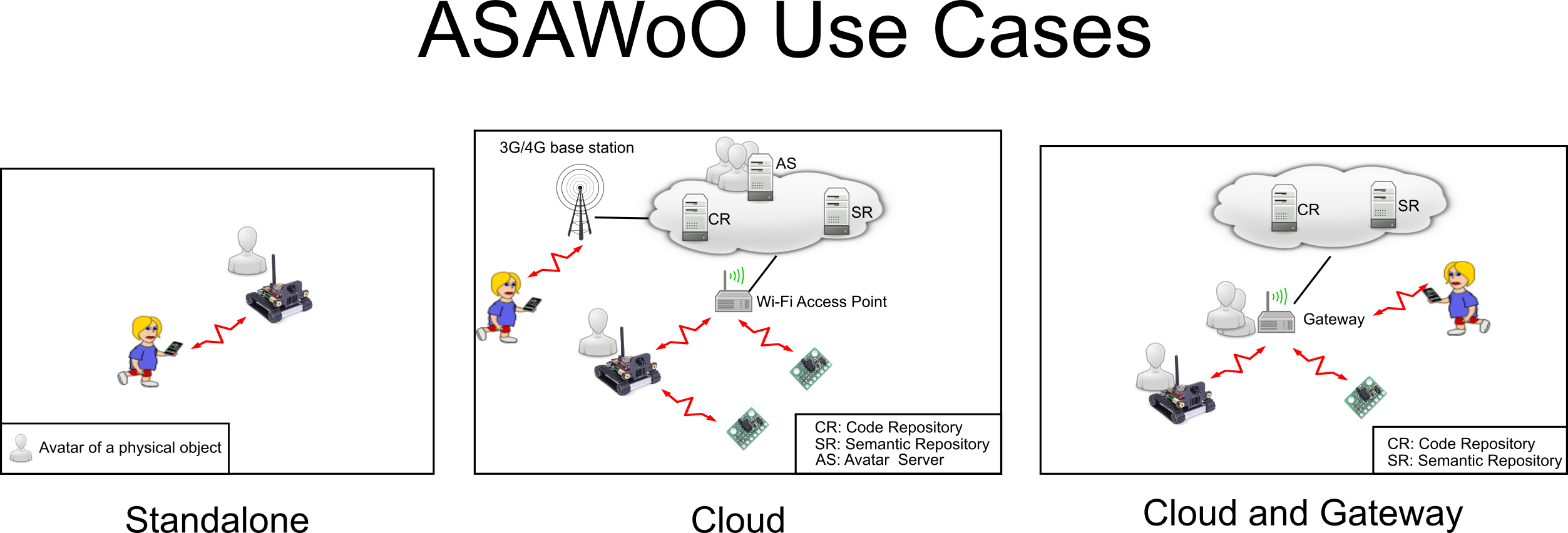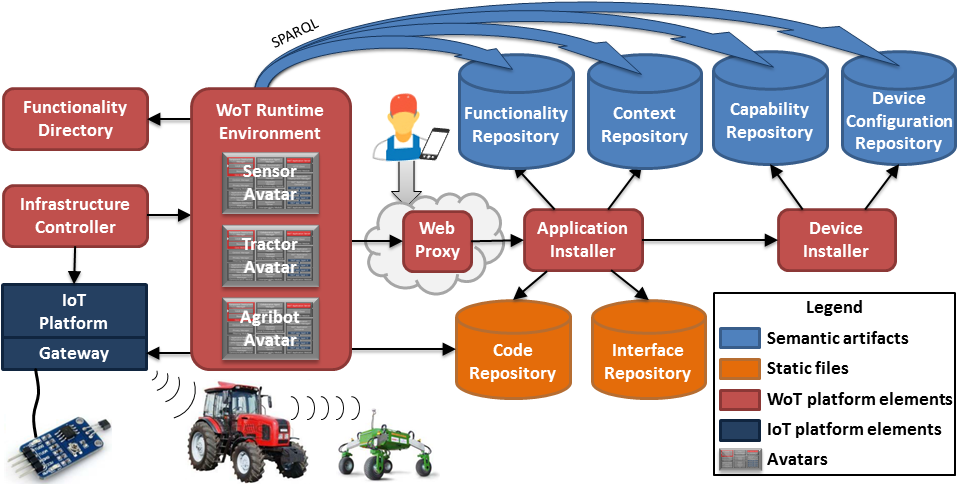The “Web of Things” (WoT) extends the Internet of Things so that physical object can be accessed and controlled using Web standards.
Project ASAWoO introduces the concept of “avatar” as a Web-compliant software extension of a thing. Physical things can therefore be coupled with avatars, to form cyber-physical objects that are compatible with WoT constraints and infrastructures. Avatars achieve interoperability between things using semantic technologies and expose high-level functionalities as RESTful resources. They can collaborate with other avatars and provide WoT applications that match end-users’ needs. Avatars are implemented using a distributed software platform that can be fully deployed on powerful objets, or distributed over resource-constrained objects and a cloud infrastructure.
ASAWoO project is funded by the French National Research Agency(https://aap.agencerecherche.fr) under contract ANR-13-INFR-0012-04.
Project documents (aka deliverables) are available on the ASAWoO Web Site
Demonstration
This video shows the ASAWoO platform running on a ROS-based robot, on a base station and on sensors. In this video, the robot is used to collect data from sensors, as well as to perform a video surveillance. When the robot detects a person in the area, it returns to its base station in order to deliver this information.
ASAWoO Use Cases
In ASAWoO, we consider 3 use cases. These uses cases are depicted in the figure below:

Standalone use case
In the standalone use case, we consider that the physical object has enough memory, storage and computing capacities to run locally an ASAWoO platform hosting its own avatar. As it is standalone, the avatar embeds all the capacities, functionalities1 and WoT applications to control the physical object. If the physical object is expected to be self adaptive or/and to collaborate with other things, it must host both the code repository and the semantic repositories, otherwise these repositories should not be installed on the physical object.
Cloud use case
In the cloud use case, we consider three kinds of objects: 1) resource-constrained objects, which have not enough resources to run an ASAWoO platform, 2) objects that run only a part of their avatar due to their limited resources and that require a cloud infrastructure to remotely run their functionalities requiring a certain amount of computing and memory capacities, 3) and powerful objects that can run an ASAWoO platform (like in the standalone use case).
In the cloud, we can deploy an ASAWoO platform to host the avatars of the physical objects, a code repository and semantic repositories.
Cloud and gateway use case
In the last case (i.e. the cloud and gateway use case), we consider that the platform that hosts the avatars is installed on a domotic gateway and not in a cloud. In this last case, only the code repository and the semantic repositories are installed in the cloud. Like in the previous use case, an avatar can be distributed on a physical object and on the gateway.
Terminology
-
Avatar: A logical software extension of a physical thing. It hosts a set of functionalities, capacities and WoT applications that allow to configure and to control the physical object, or that allow the physical object to perform given tasks in an autonomous and/or collaborative way. It exposes some of its functionalities as REST services so that these functionalities can be exploited by other avatars or by pieces of code of WoT applications running on WoT clients.
-
WoT Application: A Web application that makes it possible to configure and to control a physical object, or a set of physical objects. WoT applications are designed to be used by people. They are provided by an avatar, run simultaneously on the avatar side and on the WoT client side (i.e. on the Web browser of the user).
-
Functionality: A functionality is a piece of code that is semantically described, that performs a computing, sensing or action task, and that is independent on a specific object.
-
Capacity: A capacity is a low-level functionality, whose implementation depends on a physical object. A capacity is also semantically described. It can be viewed as a “glue” between a functionality –that is independent on an object– and a physical object.
-
WoT Runtime: The runtime that hosts and execute the avatars.
-
WoT Platform: The WoT ASAWoO platform is composed of a (or a set of) WoT runtime(s), of semantic repositories and of a code repository.
-
Code repository: A repository from which avatars can download functionalities to install them locally.
Avatar and platform architecture
Avatar architecture
As shown in the figure below, an avatar is based on a set of managers.
![]()
Platform architecture
A platform can host serveral avatars. A platform is basically composed of a runtime environment hosting avatars, of a set of semantic repositories (context, capacities, functionalities, and WoT application), and of a code repository. A platform also has a manager to instanciate the avatars.

-
Capacity, Functionality and WoT application are defined in the terminology section. ↩︎
